What Does it Take to Be an Equal Opportunity Representative or Officer?
Job Description & Duties Monitor and evaluate compliance with equal opportunity laws, guidelines, and policies to ensure that employment practices and contracting arrangements give equal opportunity without regard to race, religion, color, national origin, sex, age, or disability.
A Day in the Life of an Equal Opportunity Representative or Officer
- Counsel newly hired members of minority or disadvantaged groups, informing them about details of civil rights laws.
- Prepare reports of selection, survey, or other statistics and recommendations for corrective action.
- Interview persons involved in equal opportunity complaints to verify case information.
- Develop guidelines for nondiscriminatory employment practices.
- Monitor the implementation and impact of guidelines for nondiscriminatory employment practices.
- Verify that all job descriptions are submitted for review and approval and that descriptions meet regulatory standards.
Featured schools near , edit
Skills Needed to be an Equal Opportunity Representative or Officer
When polled, Equal Opportunity Representatives and Officers say the following skills are most frequently used in their jobs:
Active Listening: Giving full attention to what other people are saying, taking time to understand the points being made, asking questions as appropriate, and not interrupting at inappropriate times.
Reading Comprehension: Understanding written sentences and paragraphs in work related documents.
Speaking: Talking to others to convey information effectively.
Critical Thinking: Using logic and reasoning to identify the strengths and weaknesses of alternative solutions, conclusions or approaches to problems.
Social Perceptiveness: Being aware of others’ reactions and understanding why they react as they do.
Writing: Communicating effectively in writing as appropriate for the needs of the audience.
Related Job Titles
- Action Officer
- Equal Opportunity Assistant
- Complaint Investigations Officer
- Field Representative
- Equal Employment Opportunity Representative (EEO Representative)
Equal Opportunity Representative or Officer Employment Estimates
In the United States, there were 288,300 jobs for Equal Opportunity Representative or Officer in 2016. New jobs are being produced at a rate of 8.2% which is above the national average. The Bureau of Labor Statistics predicts 23,700 new jobs for Equal Opportunity Representative or Officer by 2026. There will be an estimated 25,900 positions for Equal Opportunity Representative or Officer per year.
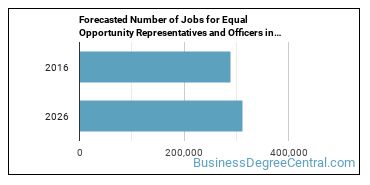
The states with the most job growth for Equal Opportunity Representative or Officer are Utah, Nevada, and Washington. Watch out if you plan on working in Alaska, Maine, or Maryland. These states have the worst job growth for this type of profession.
Do Equal Opportunity Representatives and Officers Make A Lot Of Money?
The typical yearly salary for Equal Opportunity Representatives and Officers is somewhere between $38,320 and $109,650.
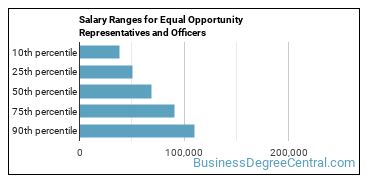
Equal Opportunity Representatives and Officers who work in District of Columbia, Alaska, or California, make the highest salaries.
How much do Equal Opportunity Representatives and Officers make in each U.S. state?
| State | Annual Mean Salary |
|---|---|
| Alabama | $67,700 |
| Alaska | $80,840 |
| Arizona | $64,340 |
| Arkansas | $56,820 |
| California | $82,380 |
| Colorado | $73,710 |
| Connecticut | $84,590 |
| Delaware | $77,670 |
| District of Columbia | $93,240 |
| Florida | $63,890 |
| Georgia | $63,030 |
| Hawaii | $69,980 |
| Idaho | $59,420 |
| Illinois | $74,180 |
| Indiana | $61,970 |
| Iowa | $63,340 |
| Kansas | $60,030 |
| Kentucky | $58,260 |
| Louisiana | $61,230 |
| Maine | $66,230 |
| Maryland | $77,250 |
| Massachusetts | $83,100 |
| Michigan | $71,470 |
| Minnesota | $76,190 |
| Mississippi | $54,700 |
| Missouri | $62,180 |
| Montana | $62,620 |
| Nebraska | $68,610 |
| Nevada | $67,540 |
| New Hampshire | $70,670 |
| New Jersey | $83,210 |
| New Mexico | $68,290 |
| New York | $76,370 |
| North Carolina | $67,100 |
| North Dakota | $70,970 |
| Ohio | $67,140 |
| Oklahoma | $59,340 |
| Oregon | $71,860 |
| Pennsylvania | $71,090 |
| Rhode Island | $76,440 |
| South Carolina | $61,390 |
| South Dakota | $57,930 |
| Tennessee | $61,780 |
| Texas | $74,690 |
| Utah | $59,470 |
| Vermont | $69,520 |
| Virginia | $75,900 |
| Washington | $84,340 |
| West Virginia | $60,740 |
| Wisconsin | $62,700 |
| Wyoming | $67,370 |
What Tools & Technology do Equal Opportunity Representatives and Officers Use?
Although they’re not necessarily needed for all jobs, the following technologies are used by many Equal Opportunity Representatives and Officers:
- Microsoft Excel
- Microsoft Word
- Microsoft Office
- Microsoft PowerPoint
- Microsoft Outlook
- Microsoft Access
- Word processing software
- Microsoft SharePoint
- Database software
- Corel WordPerfect
- IBM Lotus 1-2-3
- Microsoft operating system
How to Become an Equal Opportunity Representative or Officer
Learn what Equal Opportunity Representative or Officer education requirements there are.
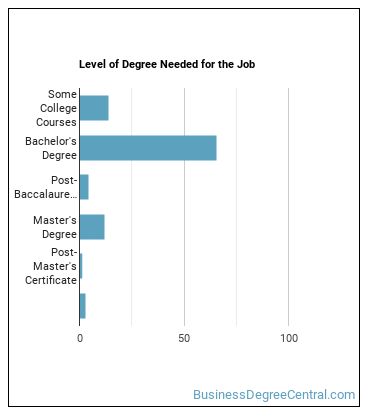
How Long Does it Take to Become an Equal Opportunity Representative or Officer?
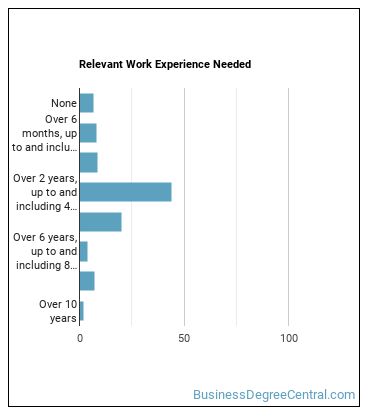
Equal Opportunity Representatives and Officers Sector
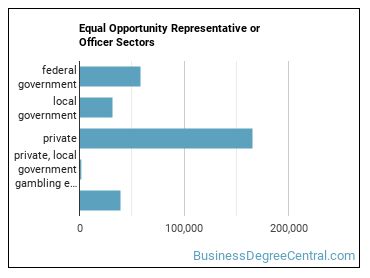
Below are examples of industries where Equal Opportunity Representatives and Officers work:
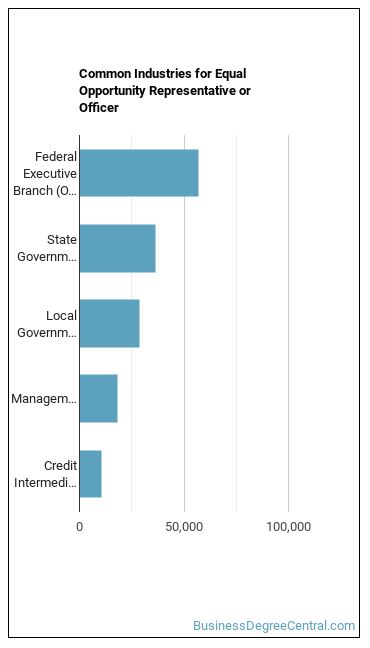
Other Jobs You May be Interested In
Those interested in being an Equal Opportunity Representative or Officer may also be interested in:
References:
More about our data sources and methodologies.
Featured Schools
You have goals. Southern New Hampshire University can help you get there. Whether you need a bachelor's degree to get into a career or want a master's degree to move up in your current career, SNHU has an online program for you. Find your degree from over 200 online programs.
Visit School
